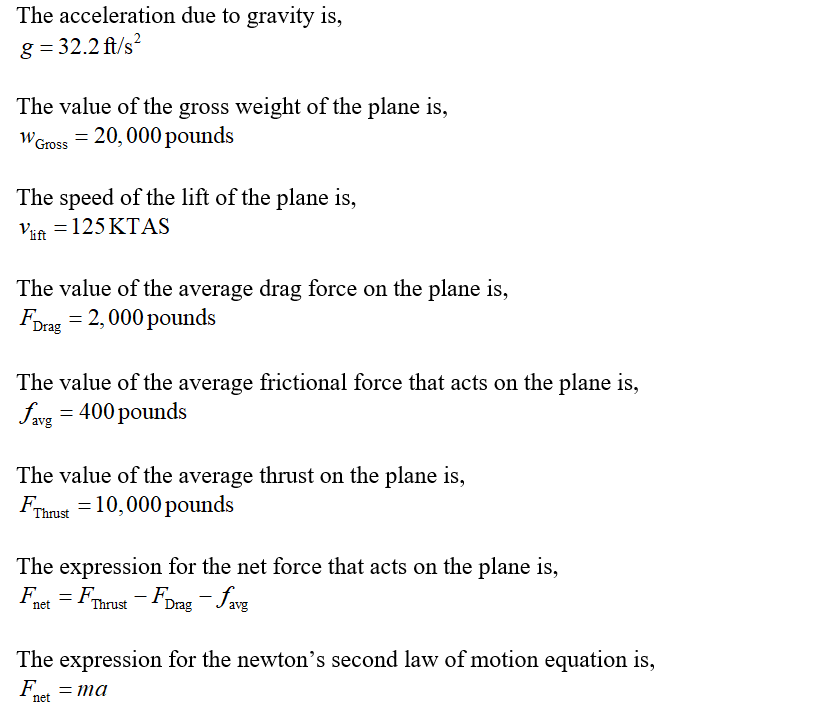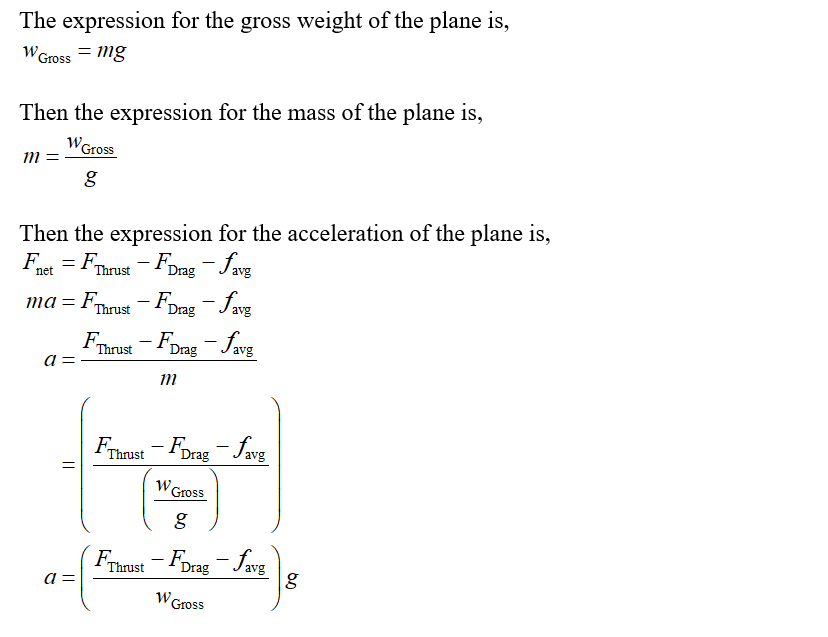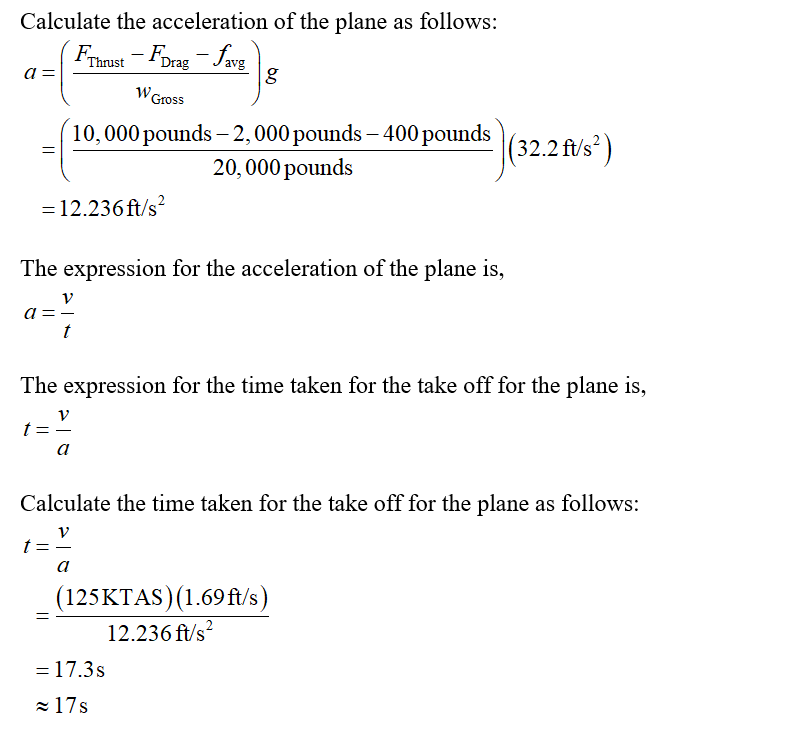Question
In: Physics
What is the time of the takeoff roll (s)? GIVEN INFORMATION: Use "g" = 32.2 ft...
What is the time of
the takeoff roll (s)?
GIVEN INFORMATION:
Use "g" = 32.2 ft / s2
1 knot = 1.69 ft / s
Gross Weight = 20,000 pounds
Lift Off Speed = 125 KTAS
Average Drag = 2,000 pounds
Average Friction Force = 400 pounds
Average Thrust = 10,000 pounds
GIVEN INFORMATION:
Use "g" = 32.2 ft / s2
1 knot = 1.69 ft / s
Gross Weight = 20,000 pounds
Lift Off Speed = 125 KTAS
Average Drag = 2,000 pounds
Average Friction Force = 400 pounds
Average Thrust = 10,000 pounds
|
10 seconds
|
||
|
14 seconds
|
||
|
17 seconds
24 seconds
|
Solutions
Related Solutions
For the reaction 2NO_2 (g)→2NO_2 (g)+O_2 (g) The data given below was collected: Time(s) [NO2] Ln[NO2]...
For the reaction 2NO_2 (g)→2NO_2 (g)+O_2 (g)
The data given below was
collected:
Time(s)
[NO2]
Ln[NO2]
1/[NO2]
0
0.110
-2.205
9.066
1
0.108
-2.229
9.294
2
0.105
-2.254
9.524
3
0.103
-2.277
9.747
Obtain the average rate of decomposition of NO_2 in units of M/s
for each interval.
What is the order of the reaction with respect to NO_2?
How long would it take for the concentration to decrease to
.0900M?
Calculate the enthalpy of the reaction 4B(s)+3O2(g)→2B2O3(s) given the following pertinent information: B2O3(s)+3H2O(g)→3O2(g)+B2H6(g), ΔH∘A=+2035 kJ 2B(s)+3H2(g)→B2H6(g),...
Calculate the enthalpy of the reaction 4B(s)+3O2(g)→2B2O3(s)
given the following pertinent information:
B2O3(s)+3H2O(g)→3O2(g)+B2H6(g), ΔH∘A=+2035 kJ 2B(s)+3H2(g)→B2H6(g),
ΔH∘B=+36 kJ H2(g)+12O2(g)→H2O(l), ΔH∘C=−285 kJ H2O(l)→H2O(g),
ΔH∘D=+44 kJ
Calculate ΔHrxn for the following reaction: CaO(s)+CO2(g)→CaCO3(s) Use the following reactions and given ΔH′s. Ca(s)+CO2(g)+12O2(g)→CaCO3(s), ΔH=...
Calculate ΔHrxn for the following reaction:
CaO(s)+CO2(g)→CaCO3(s)
Use the following reactions and given ΔH′s.
Ca(s)+CO2(g)+12O2(g)→CaCO3(s),
ΔH= -812.8 kJ
2Ca(s)+O2(g)→2CaO(s), ΔH=
-1269.8 kJ
Express your answer using four significant figures.
Please help I keep getting all the wrong answers.
Calculate ΔHrxn for the following reaction: CaO(s)+CO2(g)→CaCO3(s) Use the following reactions and given ΔH values: Ca(s)+CO2(g)+12O2(g)→CaCO3(s),...
Calculate ΔHrxn for the following reaction:
CaO(s)+CO2(g)→CaCO3(s)
Use the following reactions and given ΔH values:
Ca(s)+CO2(g)+12O2(g)→CaCO3(s), ΔH= -812.8 kJ
2Ca(s)+O2(g)→2CaO(s), ΔH= -1269.8 kJ
Express your answer using four significant figures.
Calculate ΔHrxn for the following reaction: Fe2O3(s)+3CO(g)→2Fe(s)+3CO2(g) Use the following reactions and given ΔH′s. 2Fe(s)+3/2O2(g)→Fe2O3(s), ΔH...
Calculate ΔHrxn for the following reaction:
Fe2O3(s)+3CO(g)→2Fe(s)+3CO2(g)
Use the following reactions and given ΔH′s.
2Fe(s)+3/2O2(g)→Fe2O3(s), ΔH =
-824.2 kJ
CO(g)+1/2O2(g)→CO2(g), ΔH =
-282.7 kJ
Calculate ΔHrxn for the following reaction: Fe2O3(s)+3CO(g)→2Fe(s)+3CO2(g) Use the following reactions and given ΔH′s. 2Fe(s)+3/2O2(g)→Fe2O3(s), ΔH...
Calculate ΔHrxn for the following reaction:
Fe2O3(s)+3CO(g)→2Fe(s)+3CO2(g)
Use the following reactions and given ΔH′s.
2Fe(s)+3/2O2(g)→Fe2O3(s), ΔH =
-824.2 kJ
CO(g)+1/2O2(g)→CO2(g), ΔH =
-282.7 kJ
Calculate ΔHrxn for the following reaction: Fe2O3(s)+3CO(g)→2Fe(s)+3CO2(g) Use the following reactions and given ΔH′s. 2Fe(s)+3/2O2(g)→Fe2O3(s), ΔH...
Calculate ΔHrxn for the following reaction:
Fe2O3(s)+3CO(g)→2Fe(s)+3CO2(g)
Use the following reactions and given ΔH′s.
2Fe(s)+3/2O2(g)→Fe2O3(s), ΔH =
-824.2 kJ
CO(g)+1/2O2(g)→CO2(g), ΔH =
-282.7 kJ
Part B Calculate the enthalpy of the reaction 4B(s)+3O2(g)→2B2O3(s) given the following pertinent information: B2O3(s)+3H2O(g)→3O2(g)+B2H6(g), ΔH∘A=+2035 kJ...
Part B
Calculate the enthalpy of the reaction
4B(s)+3O2(g)→2B2O3(s)
given the following pertinent information:
B2O3(s)+3H2O(g)→3O2(g)+B2H6(g), ΔH∘A=+2035
kJ
2B(s)+3H2(g)→B2H6(g), ΔH∘B=+36
kJ
H2(g)+12O2(g)→H2O(l), ΔH∘C=−285
kJ
H2O(l)→H2O(g), ΔH∘D=+44
kJ
Express your answer with the appropriate units.
Hints
Calculate ΔrH for the following reaction: C(s)+H2O(g)→CO(g)+H2(g) Use the following reactions and given ΔrH's. C(s)+O2(g)→CO2(g), ΔrH=...
Calculate ΔrH for the following reaction:
C(s)+H2O(g)→CO(g)+H2(g)
Use the following reactions and given ΔrH's.
C(s)+O2(g)→CO2(g), ΔrH= -393.5 kJmol−1
2CO(g)+O2(g)→2CO2(g), ΔrH= -566.0 kJmol−1
2H2(g)+O2(g)→2H2O(g), ΔrH= -483.6 kJmol−1
Express your answer using one decimal place.
Given the following information, answer these questions. P4(g) + 5 O2(g) → P4O10(s) ΔG⁰298 = −2748...
Given the following information, answer these questions.
P4(g) + 5 O2(g) →
P4O10(s)
ΔG⁰298 = −2748 kJ/mol2 H2(g) +
O2(g) → 2 H2O(l)
ΔG⁰298 = −474.2
kJ/molP4O10(s) + 6
H2O(l) → 4
H3PO4(l)
ΔG⁰298 = −349 kJ/mol
(a)
Determine the standard free energy of formation, ΔG⁰f
(in kJ/mol), for phosphoric acid from this information.(Assume that
ΔG⁰298 for all elemental substances is negligible.)
_______ kJ/mol
(b)
How does your calculated result compare to the value in the
Standard State Thermodynamic Data...
ADVERTISEMENT
ADVERTISEMENT
Latest Questions
- The three questions are basically looking for an observation, asking the question and then giving the...
- YOU are the financial officer at an Austrian company that wants to BUY USD 1.000.000 of...
- Please read the whole program (all the way to the bottom), Thanks in advance! Develop car...
- A)Consider the following gases, all at STP: Ne, SF6, N2, CH4. Which gas is most likely...
- Coors and Anheuser-Busch (Budweiser) are competing against each other to try to capture a larger share...
- a) How much heat is required to change a 31.3 g ice cube from ice at...
- Two hockey pucks are moving to the right with puck 1 behind puck 2. Puck 1...
ADVERTISEMENT




 genius_generous answered 2 months ago
genius_generous answered 2 months ago